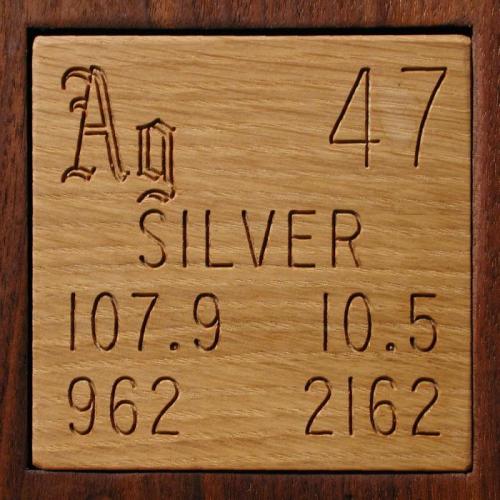Sassanian Dirham of Chosroes II.
This certainly takes the prize for oldest sample: 1400 years. [But see the tetradrachm below for an even older sample added a few years later.] Dan Lewis, a coin dealer (click on source link below for contact information), sent it for free (!) because it's broken and he thought it would make a good silver sample, which it certainly does. It's quite brittle, which indicates it's not terribly pure. In fact, analysis by x-ray fluorescence spectroscopy at the Center for Microanalysis of Materials, University of Illinois (partially supported by the U.S. Department of Energy under grant DEFG02-91-ER45439) indicates that it's 93.5% silver, 6.5% copper, but let's see you do any better 1400 years ago!
I asked Dan how much he though this coin would have been worth when it was minted. He said he could only guess that because of its size and silver content it was probably fairly valuable, certainly more than a week's wages. So maybe someone bought a horse with it one time, or used a handful to buy a Roman as a slave. Given how long it was probably in circulation, it's no doubt been used to buy a lot of things by a lot of people. History is funny that way, especially when you're holding it in your hand.
Dan sent the following interesting history of this type of coin:
From Ardashir I in 211 A.D. to Yazdegerd III (632-651 A.D.) a series of 42 Sassanian kings ruled over Persia. The Sassanians were ardent devotees of the Zoroastrian doctrine. This fire cult was vigorously disseminated throughout the empire.
In the early period they were the most persistent and successful foe of the Romans. In 260 A.D. the Roman emperor Valerian, while marching through Mesopotamia, was captured and spent the rest of his life as a captive. A century later, in 363 A.D. the Roman emperor Julian II (The Apostate) died from wounds suffered fighting the Sassanians in their capital city of Ctesiphon, near Baghdad. His successor, Jovian, found his situation so perilous that he could only extricate himself and his army by a humiliating peace which ceded many possessions along the Tigres, the great fortress at Nisibis and a Roman pledge to abandon Armenia.
One of the last Sassanian kings, Chosroes II (590-628 A.D.) appears on the obverse of this coin. When his friend and ally the Byzantine Emperor Maurice was assassinated in 602, Chosroes II embarked on an initially successful, protracted campaign of revenge against the Romans. In 614 he invaded and sacked Jerusalem and carried off the remains of the Holy Cross to Ctesiphon. Chosroes fortunes changed when the Byzantine Emperor Heraclius retook lost territories from the Persians and finally in 627 returned the Cross to Jerusalem. This event was well received by Christians who celebrate the event at the annual feast of the Exaltation of the Cross.
Chosroes weakness led to the defeat of the Persians by the Byzantines. During the ensuing revolution Chosroes was deposed and murdered by his son Kavadh II in 628. One hundred years of nearly constant war with the Byzantines and Chosroes incompetence left the Sassanian Empire crippled and vulnerable to their demise at the hands of the emerging Islamic Arabs.
This coin is an example of late 6th and early 7th century Persian craftsmanship during the zenith of the Sassanian Empire. That empire emerged over a ten year period beginning in circa 224 A.D. when King Ardashir I expanded his local fiefdom in Iran to include all of Iran, Iraq, Afghanistan, and much of the remainder of central Asia. He introduced a new coinage with his own crowned portrait on the obverse, his throne and a Zoroastrian fire altar on the reverse and inscriptions in the Pahlavi language. Although the portraits and styles would change with each succeeding reign, the basic design would remain for 450 years. The most significant image change was made by Ardashir's son, Shapur I (241-270 A.D.) when the throne was eliminated and the altar was flanked by two holy figures. Later, mintmarks and regnal dates would appear. Some of the royal crowns that are pictured were reputed to be so heavy with gold and jewels that the wearer had to have them suspended from the ceiling above the throne by chains in order to wear them.
Source: Dan Lewis
Contributor: Dan Lewis
Acquired: 18 June, 2002
Text Updated: 19 February, 2006
Price: Donated
Size: 1"
Purity: 93.5%
Sample Group: Coins
|
| 
|
|